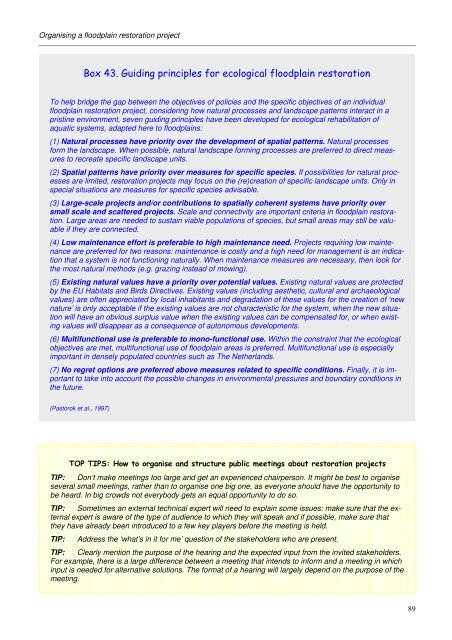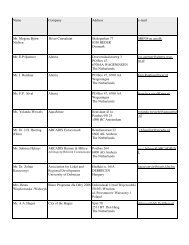HOW TO USE FLOODPLAINS FOR FLOOD RISK ... - SGGW
HOW TO USE FLOODPLAINS FOR FLOOD RISK ... - SGGW
HOW TO USE FLOODPLAINS FOR FLOOD RISK ... - SGGW
Create successful ePaper yourself
Turn your PDF publications into a flip-book with our unique Google optimized e-Paper software.
Organising a floodplain restoration project<br />
$! 3<br />
To help bridge the gap between the objectives of policies and the specific objectives of an individual<br />
floodplain restoration project, considering how natural processes and landscape patterns interact in a<br />
pristine environment, seven guiding principles have been developed for ecological rehabilitation of<br />
aquatic systems, adapted here to floodplains:<br />
(1) Natural processes have priority over the development of spatial patterns. Natural processes<br />
form the landscape. When possible, natural landscape forming processes are preferred to direct measures<br />
to recreate specific landscape units.<br />
(2) Spatial patterns have priority over measures for specific species. If possibilities for natural processes<br />
are limited, restoration projects may focus on the (re)creation of specific landscape units. Only in<br />
special situations are measures for specific species advisable.<br />
(3) Large-scale projects and/or contributions to spatially coherent systems have priority over<br />
small scale and scattered projects. Scale and connectivity are important criteria in floodplain restoration.<br />
Large areas are needed to sustain viable populations of species, but small areas may still be valuable<br />
if they are connected.<br />
(4) Low maintenance effort is preferable to high maintenance need. Projects requiring low maintenance<br />
are preferred for two reasons: maintenance is costly and a high need for management is an indication<br />
that a system is not functioning naturally. When maintenance measures are necessary, then look for<br />
the most natural methods (e.g. grazing instead of mowing).<br />
(5) Existing natural values have a priority over potential values. Existing natural values are protected<br />
by the EU Habitats and Birds Directives. Existing values (including aesthetic, cultural and archaeological<br />
values) are often appreciated by local inhabitants and degradation of these values for the creation of ‘new<br />
nature’ is only acceptable if the existing values are not characteristic for the system, when the new situation<br />
will have an obvious surplus value when the existing values can be compensated for, or when existing<br />
values will disappear as a consequence of autonomous developments.<br />
(6) Multifunctional use is preferable to mono-functional use. Within the constraint that the ecological<br />
objectives are met, multifunctional use of floodplain areas is preferred. Multifunctional use is especially<br />
important in densely populated countries such as The Netherlands.<br />
(7) No regret options are preferred above measures related to specific conditions. Finally, it is important<br />
to take into account the possible changes in environmental pressures and boundary conditions in<br />
the future.<br />
(Pastorok et al., 1997)<br />
# 9 . , - / - 3<br />
TIP: Don’t make meetings too large and get an experienced chairperson. It might be best to organise<br />
several small meetings, rather than to organise one big one, as everyone should have the opportunity to<br />
be heard. In big crowds not everybody gets an equal opportunity to do so.<br />
TIP: Sometimes an external technical expert will need to explain some issues: make sure that the external<br />
expert is aware of the type of audience to which they will speak and if possible, make sure that<br />
they have already been introduced to a few key players before the meeting is held.<br />
TIP: Address the ‘what’s in it for me’ question of the stakeholders who are present.<br />
TIP: Clearly mention the purpose of the hearing and the expected input from the invited stakeholders.<br />
For example, there is a large difference between a meeting that intends to inform and a meeting in which<br />
input is needed for alternative solutions. The format of a hearing will largely depend on the purpose of the<br />
meeting.<br />
89




